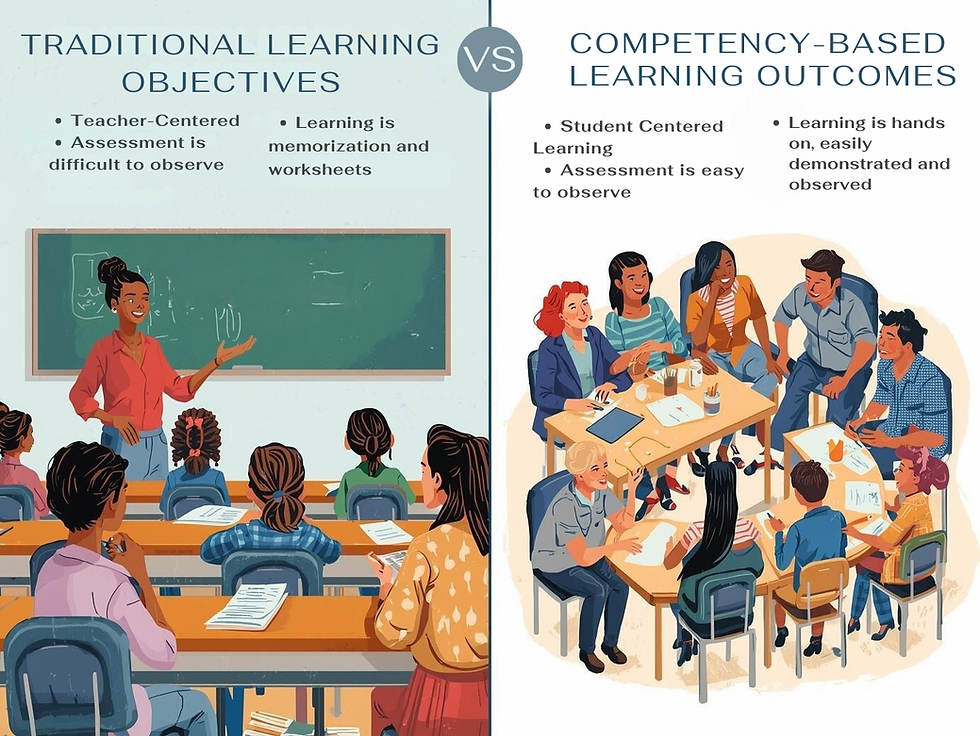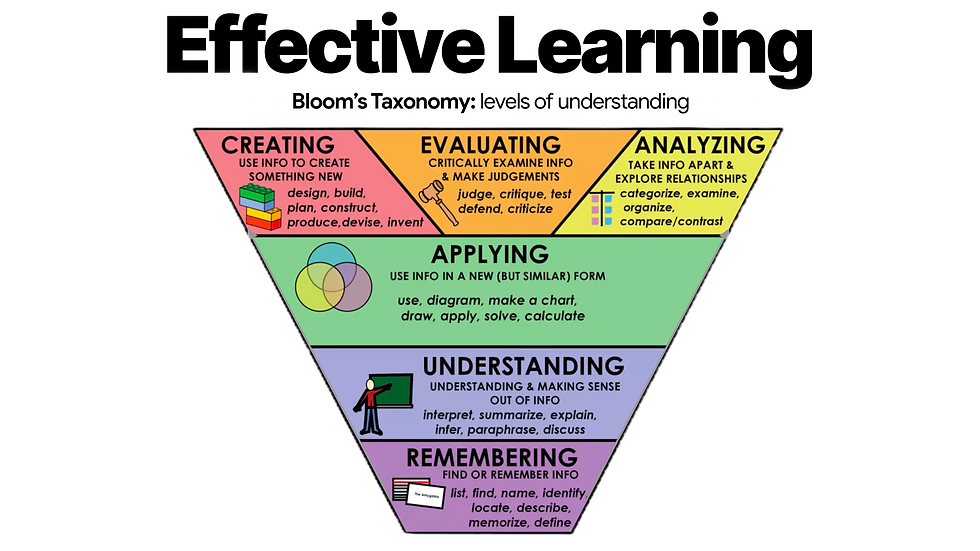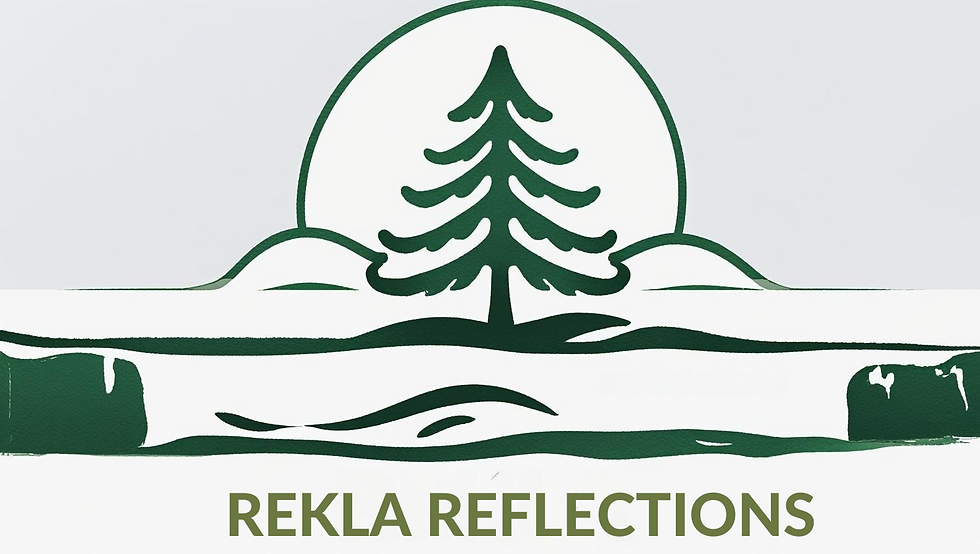🌱 From Content to Competency: Why Skills & Outcomes Matter More Than Objectives
- vanessa speigle
- Sep 18
- 4 min read
Have you ever written a lesson objective that sounded good on paper, but didn’t really convey what your students learned? That’s not unusual and it’s frustrating for teachers everywhere, because a lesson objective often fails to specify the learning students should demonstrate or the evidence teachers should observe.

In Finland, education research has moved away from this teacher-centered approach. Instead of focusing on what the teacher intends to cover, Finnish pedagogy emphasizes competencies, the skills and habits that students can demonstrate, like critical thinking, collaboration, communication, creativity, and well-being. Competencies are observable, flexible, and designed to reveal learning in action rather than on paper.
This is why Finland has sustained high performance with less testing, shorter school days, and more trust in teachers: because the focus is always on what students can do with their learning.
🌱 The Problem with Objectives
Objectives are usually teacher-centered: “I will teach fractions” or “Students will be introduced to ecosystems.” These statements spotlight content or exposure, not mastery. They focus on what the teacher will cover in class.
Studies have found that objectives often predict the teacher’s activity, not the student’s achievement. In other words, objectives describe what the teacher delivers, not what students achieve.
🌱 The Shift to Competency-Based Planning
Competencies invert the focus. They ask: What can students show, demonstrate, or communicate as evidence of learning?
In Finnish pedagogy, competencies are expressed through transversal skills: communication, collaboration, critical thinking, cultural awareness, creativity, well-being.
In Kenya’s CBC, competencies are the backbone of the curriculum, the seven anchors that every subject must connect back to.
By focusing on competencies, planning becomes lighter for teachers and clearer for students, because the emphasis shifts from covering every page of content to highlighting the essential skills and demonstrations that truly reveal learning. Teachers no longer script every step, and students grasp exactly what success demands.
🌱 Why Competency Planning Works
1. Clarity Through Action Verbs

When we use precise verbs, outcomes become observable. Bloom’s Taxonomy is one of the most powerful tools here. It supplies verbs like retell, explain, compare, model, justify, words that describe actions students can perform and products they can create.
Compare these two statements:
Objective: “Students will learn about the Cold War.”
Outcome: “Students will compare two Cold War events and explain their impact using primary or secondary sources.”
Notice how the second example highlights for the teacher exactly what to observe and signals to the student exactly what to demonstrate.
2. Assessment-Ready Outcomes
Competency-driven outcomes connect directly to evidence of learning. If students are asked to “retell” or “defend,” the teacher can structure a product, peer conversation, or reflection that illustrates progress.

This closes the gap between planning and assessment because they function as two sides of the same coin.
3. Student Agency
When students encounter clear outcomes phrased in action verbs, they recognize what success looks like. Research from Pasi Sahlberg (Finnish Lessons 3.0) shows that students engage more deeply when they understand the skill they are working toward. This cultivates autonomy, motivation, and confidence.
4. Bloom’s Research on Mastery Learning
Benjamin Bloom’s work in the 1960s and 70s extended beyond his taxonomy of verbs. His research on mastery learning demonstrated that students thrive when teachers:
Define learning goals in clear, measurable terms.
Provide frequent opportunities for feedback and corrective practice.
Offer multiple pathways and moments for students to demonstrate mastery.
In practice, this means outcomes should not just be clear, they should also be flexible. If the competency is “Students will be able to explain the water cycle,” one student might draw it, another might narrate it, and another might construct a model. Bloom’s research confirms that clarity + flexibility cultivate deeper, more equitable learning.
🌱 A Practical Step: Apply Bloom’s Verbs to Your Outcomes
You don’t have to overhaul your entire lesson plan to begin. A simple way to start is by replacing vague objectives with Bloom’s action verbs.
Try this exercise:
Select one of your current objectives.
Highlight the verb (often “learn about” or “understand”).
Replace it with a Bloom’s verb that makes the outcome observable.
Examples:
“Students will learn about ecosystems” → “Students will model an ecosystem and explain interactions between organisms.”
“Students will understand the main idea” → “Students will retell the main idea in 3 sentences and support it with one example.”
Even this small revision transforms assessment, because now you know exactly what evidence to look for.
🌱 Conclusion: A Mindset Shift That Lightens the Load
Shifting from objectives to outcomes is more than a semantic change, it’s a
mindset shift. It sharpens expectations for students, aligns assessment with learning, and reduces planning stress for teachers.
You’ve just seen how Bloom’s Taxonomy can strengthen your outcomes and connect them to evidence but still be aligned with Finnish Pedagogy. 🌱

👉 If you’re ready to go further, to redesign objectives step by step into competency-driven outcomes, with templates, practice pages, and a full worked sample lesson plan, check out our new Rekla How-To Guide: From Content to Competency, available now in the Rekla Store for $7.

If you are more of an auditory learner, you can listen to the step by step guidance in our Rekla Reflections Podcast for this week.
The topic......From Content to
Competency with Bloom's Taxonomy.
Our YouTube Channel will also bring more insights into this theme and topic because teacher energy = student energy and lesson planning can zap that energy. So let's dive into how to change that here.




Comments